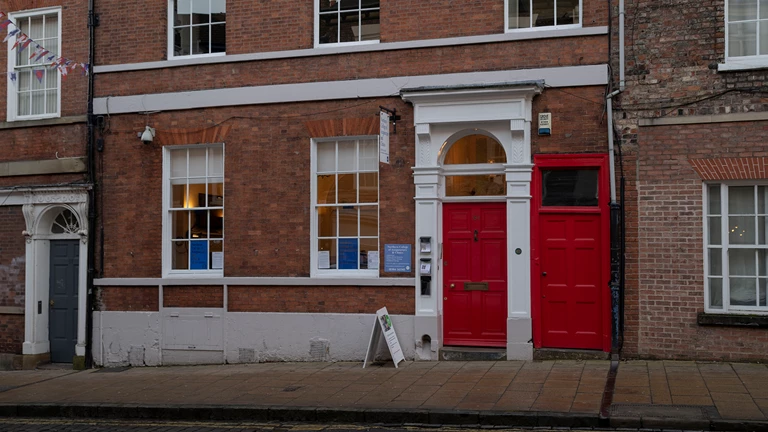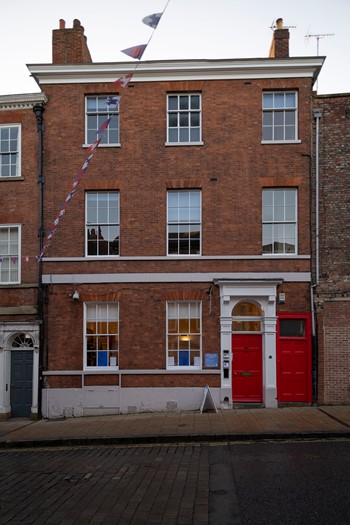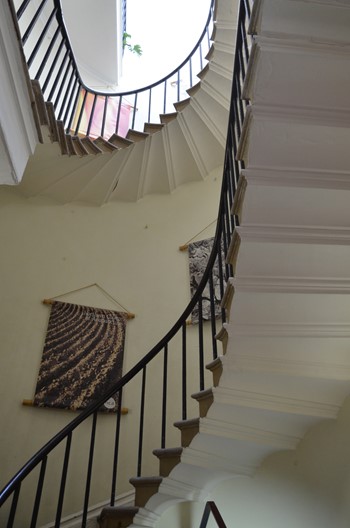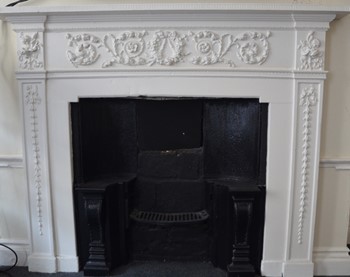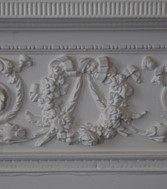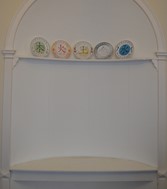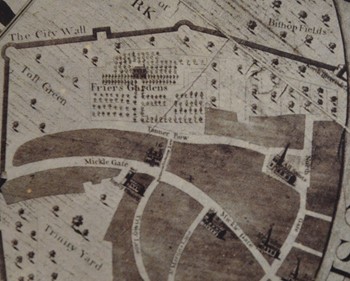61 Micklegate
Home to founders of the world’s first horticultural society and a rare kitchen range.
Built for the plantsman and nursery owner George Telford in 1786, it is highly probable that no. 61 Micklegate was designed by the eminent York architect, Thomas Atkinson.
A handsome three storey townhouse, the building comprises a basement and three floors built in a high status Flemish bond red brick with stone dressings. Standing on a painted stone plinth, it also has a shuttered opening giving access to one of the basement rooms.
The main entrance on the right, remodelled in the nineteenth century, has a plain fanlight set between decorated brackets. Adjoining this is a narrow side passage with a six panel door and fanlight. Previous descriptions of this arrangement suggested this was unusual, but it was common from medieval times to have a side passage available from the main road, especially when rear access to the site was restricted.
Above the doors, a pair of graduated stone sill bands separate the ground and first floor windows, which, prior to 1993, were mostly Victorian one pane sash but the 12 and 9 pane sash windows were reinstated based on an original surviving example on the first floor.
Inside the house the brick vaulted cellar has a rare Eagle closed system kitchen range in the back room. Designed and built by the Eagle Range and Grate Company, Birmingham it was the real ‘Rolls Royce’ of kitchen equipment. Developed in the late 19th century, they were more durable than previous closed range systems being easy and economical to use. Constructed with iron flues they needed little masonry work to install; however, they were more expensive than earlier brick set ranges and subsequently were usually installed in the kitchens of the wealthy houses and royal palaces.
This range boasts two ovens, a boiler and a firebox that supplied hot gas which would circulate around each component before exiting via the flue. The cover of the firebox could be lifted to function as an open grate for roasting, hence the presence of two pivoting ‘cranes’ found above. Also a sliding flue damper gave the cook more control, not just over cooking temperatures but also fuel consumption.
In the hall the quality of the secondary cantilevered stair is also a remarkable feature of this house. With its elegant carved stone treads and cast-iron hollow-sided balusters and handrail, it sweeps up through the floors to what appears to be an oval lantern. The shape, however, is a clever illusion created by a curved five foot high wall built on the attic landing.
The other important aspect of this beautiful town house is the decoration in the ground floor front room, clearly influenced by the original owner George Telford.
In 1768 George and his brother John were founder members of The Ancient Society of York Florists, which is the first and oldest existing horticultural society in the world, pre-dating the Royal Horticultural Society by some 35 years. Members of the York Society included several of York’s professional nurserymen to cultivate so-called ‘florists’ flowers’ for interest and pleasure, not for sale in the cut flower trade.
“Happiness being the ultimate end proposed by the Society.”
Originally, only six varieties were accepted for display at the Society’s regular shows and competitions, these were: Auricula, Primula, Anemone, Polyanthus, Tulip and Carnation. Pinks were accepted later, followed by Dahlias and Chrysanthemums in the 19th century. Given its age, it’s no surprise that the Society also holds the record for the world’s longest running horticultural show, running, uninterrupted, throughout both World Wars.
Back to the front room of no. 61 Mickelgate and you’ll find some unusual features around the fireplace. The frieze, for example, has a traditional scrolling branch motif known as a rinceau decorated with leaves and flowers, but at the centre is a tied valedictory garland comprised of many of the Society of York Florists’ flowers. On the terminal blocks at the ends of the frieze are bold floral posies featuring more of these particular flowers and they sit above fielded pilasters decorated with pendants of wheatear drops.
Displayed florist flowers were often grouped together for greater effect and a popular method became known as an ‘Auricula Theatre’: an arrangement of tiered shelving usually intended for outdoor spaces in pavilion niches or garden logia - the RHS Chelsea Flower Show often features such displays. It is rare and perhaps unique to come across a permanent indoor display space intended for this purpose and the wide, shallow niche on the south wall of the room seems to ideally fulfil this function.
When George died in 1834 the freehold of the house remained with the family until 1894 when the building was acquired by the renowned antiquarian and physician Dr WA Evelyn. Evelyn’s nationally important collection, now in York Art Gallery, has grown to include some 4,000 prints, drawings and watercolours of York. Yale University in the United States sought to purchase the original smaller collection in 1931, but a local and national fundraising campaign managed to keep it in York.
The Conservation Trust acquired no. 61 Micklegate in 1993. Following a major refurbishment, including the sensitive introduction of a lift rising through three floors and an extension at the rear, the Northern College of Acupuncture has taken up the lease and welcomes cohorts of students through its doors every year.
Discover more about no. 61 Micklegate
61 Micklegate
York
YO1 6LJ
Operated by Northern College of Acupuncture
Tel: 01904 343 305
Historic England Grade ll* listed building
The Telford family, nurserymen of York
From 1655 the Telford family built their York nursery business and, taking over from their father on his death in 1771, throughout the 18th century brothers George and John Telford were well known nurserymen with a flourishing business.
The nursery was not just renowned for trees, it also supplied seeds and plants to wealthy landowners, including John Aislabie at Studley Royal, Sir William Vavasour of Hazelwood Castle and the Grimston family at Kilnwick.
“The site of this ancient monastery is now occupied by Mr.Tilford (sic) a worthy citizen and whose knowledge in the mystery of gardening renders him a credit to his profession, being one of the first that brought northern gentry into the method of planting and raising all kinds of forest trees for use and ornament.”
Francis Drake in his 1736 book on York 'Eboracum'
Not all landowners, however, were won over, Edward Lascelles at Harewood was scathing about northern nurseries. From London he wrote: “I shall bring some tube Roses roots. There is no depending upon country nurserymen for anything of this kind that is not quite common.”
The confidence of the Telford’s was not dented with George and John producing one of the earliest comprehensive plant catalogues in 1775. The catalogue featured forest and fruit trees, evergreens, flowering shrubs, perennial flower roots, and bulbous flowers, all priced for purchase and transportation, including costs for sending to the American colonies. There were nine varieties of broom and cytisus, 14 of honeysuckle, 12 jasmines and a list of 41 roses costing between two shillings and two pounds. More exotic plants were available, Catesby’s all spice, olive leaf kalmia, swamp magnolia, rhododendron, laburnum, lilac, rosemary and syringa were available, whilst for six pence each you could have an almond tree, a bay tree, a cornelian cherry or purple mezereon. In 1740 the business supplied 340 elm trees to enhance the New Walk alongside the Ouse.
The company flourished well into the 19th century until the brothers, by this time in their late sixties, sold the business to brothers Thomas and James Backhouse in 1816. Another resident of Micklegate, James Backhouse lived further up the hill at no. 90 and this gave him easy access to the nursery from the rear. It would be the renamed Backhouse Nursery that replaced the New Walk elm trees in 1824. A Quaker Minister, James would go on to become a highly renowned nurseryman and botanist.

